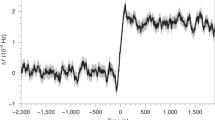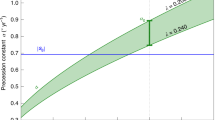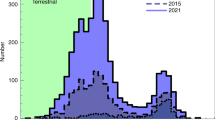Abstract
Venus rotates very slowly on its axis in a retrograde direction, opposite to that of most other bodies in the Solar System1. To explain this peculiar observation, it has been generally believed2,3,4,5,6 that in the past its rotational axis was itself rotated to 180° as a result of core–mantle friction inside the planet, together with atmospheric tides. But such a change has to assume a high initial obliquity (the angle between the planet's equator and the plane of the orbital motion). Chaotic evolution7, however, allows the spin axis to flip for a large set of initial conditions6,8. Here we show that independent of uncertainties in the models, terrestrial planets with dense atmosphere like Venus can evolve into one of only four possible rotation states. Moreover, we find that most initial conditions will drive the planet towards the configuration at present seen at Venus, albeit through two very different evolutionary paths. The first is the generally accepted view whereby the spin axis flips direction2,3,4,5,6. But we have also found that it is possible for Venus to begin with prograde rotation (the same direction as the other planets) yet then develop retrograde rotation while the obliquity goes towards zero9: a rotation of the spin axis is not necessary in this case.
This is a preview of subscription content, access via your institution
Access options
Subscribe to this journal
Receive 51 print issues and online access
$199.00 per year
only $3.90 per issue
Buy this article
- Purchase on Springer Link
- Instant access to full article PDF
Prices may be subject to local taxes which are calculated during checkout




Similar content being viewed by others
References
Carpenter, R. L. A radar determination of the rotation of Venus. Astron. J. 75, 61–66 (1970).
Lago, B. & Cazenave, A. Possible dynamical evolution of the rotation of Venus since formation. Moon Planets 21, 127–154 (1979).
Dobrovolskis, A. R. Atmospheric tides and the rotation of Venus. II - Spin evolution. Icarus 41, 18–35 (1980).
Shen, M. & Zhang, C. Z. Dynamical evolution of the rotation of Venus. Earth Moon Planets 43, 275–287 (1989).
McCue, J. & Dormand, J. R. Evolution of the spin of Venus. Earth Moon Planets 63, 209–225 (1993).
Yoder, C. F. Venus II: Geology, Geophysics, Atmosphere, and Solar Wind Environment 1087 (Univ. Arizona Press, Tucson, 1997).
Laskar, J. & Robutel, P. The chaotic obliquity of the planets. Nature 361, 608–612 (1993).
Néron de Surgy, O. Influence des Effets Dissipatifs sur les Variations à Long Terme des Obliquités Planétaires. Thesis, Observatoire de Paris (1996).
Kundt, W. Spin and atmospheric tides of Venus. Astron. Astrophys. 60, 85–91 (1977).
Néron de Surgy, O. & Laskar, J. On the long term evolution of the spin of the Earth. Astron. Astrophys. 318, 975–989 (1997).
Yoder, C. F. Venus' free obliquity. Icarus 117, 250–286 (1995).
Chapman, S. & Lindzen, R. Atmospheric Tides. Thermal and Gravitational (Reidel, Dordrecht, 1970).
Kaula, W. Tidal dissipation by solid friction and the resulting orbital evolution. Rev. Geophys. 2, 661–685 (1964).
Munk, W. H. & MacDonald, G. J. F. The Rotation of the Earth, a Geophysical Discussion (Cambridge Univ. Press, Cambridge, 1960).
Rochester, M. G. The secular decrease of obliquity due to dissipative core-mantle coupling. Geophys. J. R. Astron. Soc. 46, 109–126 (1976).
Goldreich, P. & Peale, S. J. The obliquity of Venus. Astron. J. 75, 273–284 (1970).
Pais, M. A. et al. Late Precambrian paradoxical glaciation and obliquity of the Earth - a discussion of dynamical constraints. Earth Planet. Sci. Lett. 174, 155–171 (1999).
Aoki, S. Friction between mantle and core of the Earth as a cause of the secular change in obliquity. Astron. J. 74, 284–291 (1969).
Gold, T. & Soter, S. Atmospheric tides and the resonant rotation of Venus. Icarus 11, 356–366 (1969).
Dobrovolskis, A. R. & Ingersoll, A. P. Atmospheric tides and the rotation of Venus. I - tidal theory and the balance of torques. Icarus 41, 1–17 (1980).
Davies, M. E. et al. The rotation period, direction of the north pole, and geodetic control network of Venus. J. Geophys. Res. 97, 13141–13151 (1992).
Dickey, J. O. Lunar laser ranging - a continuing legacy of the Apollo program. Science 265, 482–490 (1994).
Walker, J. C. G. Evolution of the atmosphere of Venus. J. Atmos. Sci. 32, 1248–1256 (1975).
Pepin, R. O. On the origin and early evolution of terrestrial planet atmospheres and meteoritic volatiles. Icarus 92, 2–79 (1991).
Hunten, D. M. Atmosphere evolution of the terrestrial planets. Science 259, 915–920 (1993).
Kasting, J. F. Earth's early atmosphere. Science 259, 920–926 (1993).
Laskar, J. The chaotic motion of the solar system. A numerical estimate of the size of the chaotic zones. Icarus 88, 266–291 (1990).
Konopliv, A. S. et al. Venus gravity and topography: 60th degree and order model. Geophys. Res. Lett. 20, 2403–2406 (1993).
Goldreich, P. & Peale, S. Spin-orbit coupling in the solar system. Astron. J. 71, 425–438 (1966).
Acknowledgements
We thank O. Néron de Surgy, M. Greff, S. Peale and C. F. Yoder for discussions. This work was supported by PNP-CNRS and by the Fundação para a Ciência e Tecnologia, Portugal.
Author information
Authors and Affiliations
Corresponding author
Rights and permissions
About this article
Cite this article
Correia, A., Laskar, J. The four final rotation states of Venus. Nature 411, 767–770 (2001). https://doi.org/10.1038/35081000
Received:
Accepted:
Issue Date:
DOI: https://doi.org/10.1038/35081000
This article is cited by
-
On the behaviour of spin–orbit connection of exoplanets
Nature Astronomy (2023)
-
Long-lived volcanic resurfacing of Venus driven by early collisions
Nature Astronomy (2023)
-
Magma Ocean, Water, and the Early Atmosphere of Venus
Space Science Reviews (2023)
-
Synergies Between Venus & Exoplanetary Observations
Space Science Reviews (2023)
-
The Habitability of Venus
Space Science Reviews (2023)
Comments
By submitting a comment you agree to abide by our Terms and Community Guidelines. If you find something abusive or that does not comply with our terms or guidelines please flag it as inappropriate.



